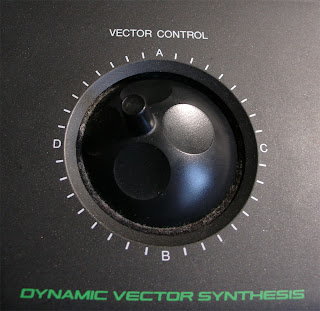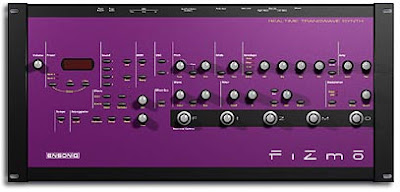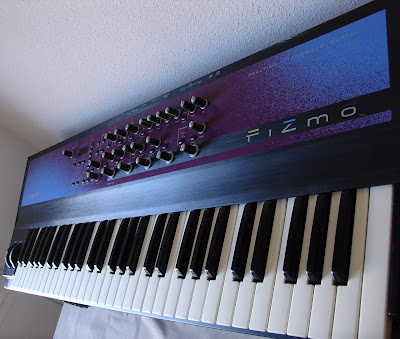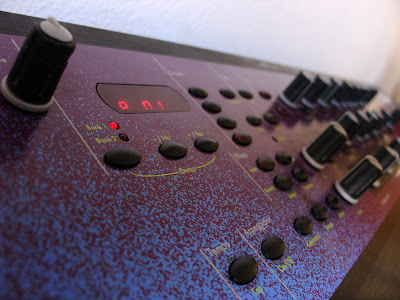 One of the reasons claimed by those who dislike it is that "it is not a true Oberheim". That's mostly true because it seems that no one of those who worked At Oberheim Electronics was involved in the creation of this synth, but that doesn't means it's a bad synth at all.
One of the reasons claimed by those who dislike it is that "it is not a true Oberheim". That's mostly true because it seems that no one of those who worked At Oberheim Electronics was involved in the creation of this synth, but that doesn't means it's a bad synth at all. Tom Oberheim (founder of the brand and creator of numerous advances in the field) left his company in 1986 to pass it at the hands of Gibson and subsequently to an Italian company called Viscount specialized in the production of organs. Viscount manufactured in 1999 this physical modeling synthesizer using the name Oberheim (under license from Gibson), probably to increase sales. Anyway, despite the fact that possibly the synthesis is not the strong side of Viscount, the result is quite impressive.
 With an massive blue metal look and a high end quality, this instrument of almost 15 kilos weight offers a good bunch of extras that, for its time, was very innovative, such as its huge graphical display or a SPDIF digital output. The control that offers is great, having a big number of knobs, faders and buttons that allow a flexible and edition. This also can be seen in real time on the LCD screen, often in graphical mode, what makes it been pointed as an ideal synthesizer for learning.
With an massive blue metal look and a high end quality, this instrument of almost 15 kilos weight offers a good bunch of extras that, for its time, was very innovative, such as its huge graphical display or a SPDIF digital output. The control that offers is great, having a big number of knobs, faders and buttons that allow a flexible and edition. This also can be seen in real time on the LCD screen, often in graphical mode, what makes it been pointed as an ideal synthesizer for learning. However let's check what is really important: the sound. Although it comes loaded with presets that are unattractive at begining, most of them are easily enhanced with some editing, others with a little patience and others are so spectacular that manipulate them should be a crime. There are sounds that are simply useless and very ill too, but just like in every machine that have fallen into my hands, and it is something that mostly depends on the value you bring to each. In my case, for example, synths that imitates trumpets, guitars and bagpipes are completely dispensable to me. Being in this case a virtual-analogic synthesizer, I find more practical the range of possibilitiesit offers to me, especially to create pads, leads or strange sounds, and in this field the OB-12 operates at ease. Other facilities offered are the thickness and the cleaning of their sounds, it's easy to obtain dense and warm pads, and also fairly fat bass sounds.
However let's check what is really important: the sound. Although it comes loaded with presets that are unattractive at begining, most of them are easily enhanced with some editing, others with a little patience and others are so spectacular that manipulate them should be a crime. There are sounds that are simply useless and very ill too, but just like in every machine that have fallen into my hands, and it is something that mostly depends on the value you bring to each. In my case, for example, synths that imitates trumpets, guitars and bagpipes are completely dispensable to me. Being in this case a virtual-analogic synthesizer, I find more practical the range of possibilitiesit offers to me, especially to create pads, leads or strange sounds, and in this field the OB-12 operates at ease. Other facilities offered are the thickness and the cleaning of their sounds, it's easy to obtain dense and warm pads, and also fairly fat bass sounds.
Regarding to specifications: 4-octave keyboard with 12 voices of polyphony in 4 parts, 256 programs and 256 presets to be shared among two oscillators (which can take up to three waves simultaneously: saw, triangle and square), noise, ring modulator and FM for the second oscillator. It includes 4 effects (Overdrive, Chorus, Delay and Reverb) and also a 5-band graphic and parametric equalizer. Furthermore it has two LFO and two filters (Lowpass , Hipass & Bandpass) serial or parallel configurable. Finally the presence of a small phrase recorder of 196 sequences or 16000 notes and morphing function between presets that can be associated with the modulation wheel or the ribbon controller.

In short, and to end this first analysis, I feel the Oberheim OB-12 as a pretty versatile synthesizer for its rank, both for the quality of his sound and for the edition ease and flexibility. I like the feeling of the keyboard and its retro look with so many knobs and buttons and the blue color that does not allow him to go unnoticed in any studio or performance. All this without forgetting that it has nearly eight years and that its last days prices at shops was around 800 euros (in Europe). Today you can find it in the second-hand market rounding the 500 euros.








